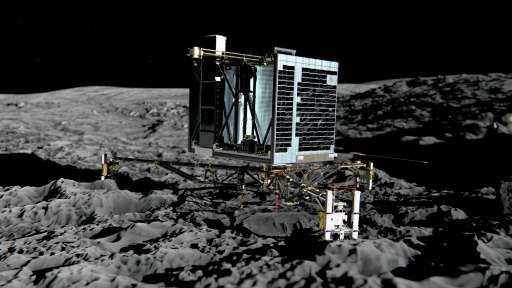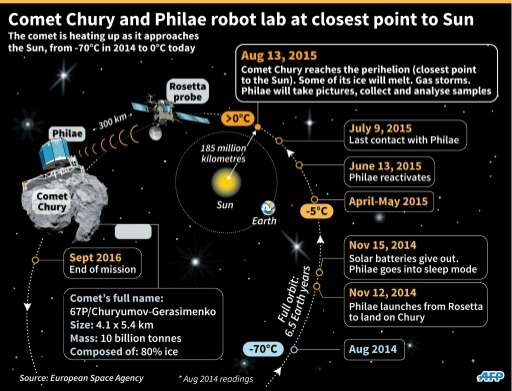Philae silver lining: robot lab shielded from sun

When a comet whizzes past the Sun on Thursday it won't mean certain high-temperature death for a European robot lab riding on the chunk of ice and dust.
Instead, the rough, off-target landing by the Philae lander—deposited on the comet's surface last November by the Rosetta spacecraft—has turned out to have a silver lining.
"It had some disadvantages. We had to reschedule everything, which had to happen really fast in the first days after landing," German Aerospace Center (DLR) spokeswoman Manuela Braun told AFP.
"But you also have the advantage that it (Philae) has really survived much longer. On its original site it would have been too hot by March or April."
In other words, if the European Space Agency's robot lab had hit the mark on Comet 67P/Churyumov-Gerasimenko last year it would have been cooked into inaction by now.
But because it bounced and tumbled to a halt on a shadier stretch of the alien surface, it might be able to witness the dramatic show on the comet as it warms.
The lander can stand temperatures of up to 50 degrees Celsius (122 degrees Fahrenheit), while the temperatures on 67P will hit roughly 80 degrees Celsius when it passes the Sun.

Burst of activity
The comet, which is made of ice, minerals and organic particles, has gone into a burst of activity prompted the approaching Sun's heat. It is spewing hundreds of kilos of gas and a tonne of dust per second.
The European Space Agency reported this week that one of the comet's outbursts was so dramatic that it pushed away the incoming power of the Sun.
"This is the brightest jet we have seen so far," said Carsten Guettler, who works on the project, and is from the Max Planck Institute for Solar System Research. "Usually the jets are quite faint."
Scientists hope the heat of perihelion will cause the enigmatic traveller to shed more of its icy crust.
If so, it could disgorge pristine particles left from the solar system's birth 4.6 billion years ago, they believe.
The comet will reach its closest point to the Sun—some 186 million kilometres (116 million miles)—at about 0200 GMT on Thursday, before embarking on another six-and-a-half year egg-shaped orbit.
But one question is whether Philae will transmit any more information from its perch on the comet.
As 67P has drawn closer to the Sun, it recharged and woke up on June 13, only to fall silent again less than a month later.
Scientists have sent "blind" commands to the lab in the hopes it will fire up and perform a few basic experiments during the comet's passage past the Sun.
"We have the advantage that it (Philae) is really now travelling alive on the comet. It could be working still for the next month," said Braun, from the German Aerospace Center. "But we still have the problem of getting into contact."
Further complicating communication is the fact that Rosetta has had to move farther away to avoid the confounding effects of the dust storm on its star-tracking navigation system.
The spacecraft now orbits at more than 300 kilometres (186 miles) from the comet, compared to less than six kilometres from the surface at its closest in February.
If Philae decides to send a message on Thursday, Rosetta will be too far away to receive it.
"Our priority is the probe," Sylvain Lodiot, head of Rosetta operations at the European Space Operations Centre, told AFP.
© 2015 AFP





















